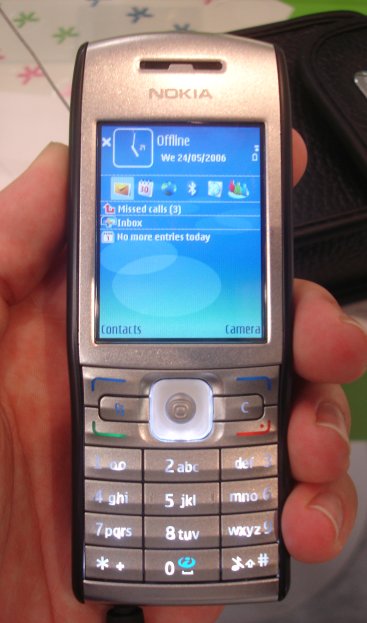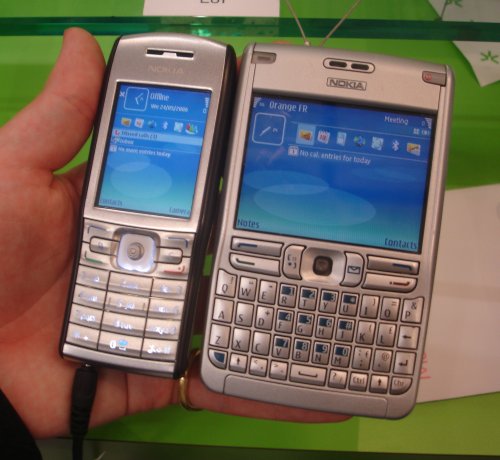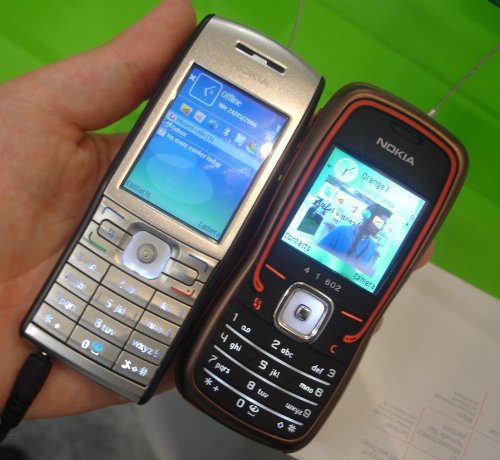 With the announcement of the E50 two weeks ago, Nokia is continuing to pushing S60 down into the mid-tier. This time it is the Enterprise segment that gets a small (113 x 43.5 x 15.5, 70cc) but powerful S60 smartphone. The E50 is a quad band GSM (850/900/1800/1900) monoblock handset with a range of Enterprise-focused software enhancements including support for push email, integration with corporate PBX's, onboard team management/communication software, and advanced remote device management.
With the announcement of the E50 two weeks ago, Nokia is continuing to pushing S60 down into the mid-tier. This time it is the Enterprise segment that gets a small (113 x 43.5 x 15.5, 70cc) but powerful S60 smartphone. The E50 is a quad band GSM (850/900/1800/1900) monoblock handset with a range of Enterprise-focused software enhancements including support for push email, integration with corporate PBX's, onboard team management/communication software, and advanced remote device management.
In handling, the size of the device compared to other smartphones is immediately noticeable. From the front, the E50 is not that much smaller than devices such as the N70 and, by contrast, the Nokia 5500, which by volume is a little bigger, at first glance looks smaller. However as soon as you turn the E50 on its side you realise it is a thin phone. The E50 is the thinnest S60 phone announced thus far, and although it shaves only a few mm off its thickness this does make a difference. It is 33% thinner than the N70 and 10% thinner than the E60. In side profile, the phone tapers in the bottom half, and this further enhances the impression that the E50 is a svelte device. Despite its size the E50 feels very solid and well put together, and the combination metallic and hard plastic casing reinforces this. The E50 feels like it could take a lot of wear and tear and should enhance Nokia's already rosy reputation for build quality.
The E50 has a QVGA (240 x 320) screen which has a sensor and automatically adjusts its brightness as necessary (this can be user controlled too). The quality of the screen is excellent, even under bright lights, and considerably eases reading of the screen when compared to lower resolution devices. QVGA screens are becoming standard for higher end phones, but are still some what rare in the mid-tier. The QVGA screen also means the E50 is better able to take advantage of the changes (smoother fonts, resizeable UI) in S60 3rd Edition when compared to lower resolution devices. The keyboard, especially when using number keys, is excellent. There are no gaps between the keys, but they are sufficiently large, have good tactile feedback and are ridged such that even those with larger fingers should have no problems. The softkeys, application key, cancel key, and the send and end keys are a little smaller, and took a few moments to get used to, but should present no problems. The joystick was responsive to directional touches (it is a stick, rather than a four way button), was also good and is given plenty of room, which should mean less accidental key presses when navigating through lists and menus.
On the left hand side of the phone there are volume up and down buttons. These work for both phone calls and multimedia. Having these buttons on the sides does make a difference because it is much easier to adjust volume mid-call (if you change from a noisy to quiet environment or vice versa). The power button is found on the top of the device and, as with other Nokia phones, allows you to quickly switch profiles (important to prevent ringtone embarrassment in meetings). On the right hand side of the device is a record key. This starts up the Recorder application which allows you to record short voice notes. Below this is the pencil key which is used for copy and paste functions and selecting multiple items from lists. The location on the side of the device makes a lot of sense since it is usually used in conjunction with other keys. Thanks to the positioning your fingers do not have to perform contortions to combine button presses.
On the back of the device is an optional 1.3 Megapixels camera. The E50 will come in two variants, one with a camera and one without. This is a result of corporate hostility towards camera phones. Cameraphones are often held up as potential industrial espionage tools, although the reality is that the USB memory stick (or a phone, such as the E50, with a USB mass storage device profile) have a much greater potential to cause problems. The camera captures stills at an unspectacular 1280x960 pixels and video at 176x144 (15 fps). There's a 4x digital zoom and the useful combination of scene modes and colour adjustments in the onboard camera software.
As can be seen from above the E50's design is relatively simple. There are not as many keys as on other devices (no multimedia key as on the Nseries, or Messaging key as on the E61). This simplicity reflects the target market, but will also be welcomed by those who feel the high end S60 devices are getting increasingly complex. While targeted as an enterprise, device I'm sure its design, S60 status and size will mean it finds some users outside of larger corporations.
The E50 has good connectivity options, with support for IrDA (IrCOMM, IrOBEX and IRTinyTP), Bluetooth 2.0 (including support for enhanced data rates), and USB (via the ubiquitous Nokia Pop-Port. As a quad band GSM phone the E50 should be useable almost anywhere in the world. For trans-Atlantic travellers who often miss the 850 band from their current phone the E50 should result in a noticeable improvement of coverage when in the US. Data transfer is provided by EDGE and GPRS. Via PC Suite the E50 can be used as a modem. PC Suite also allows for desktop sync, desktop message sending and contacts editing, third party application installation, phone backup and multimedia transfer.
The Enterprise targeting of the E50 comes from the software that is available with or for the phone. Voice features include conference calling (up to 6 participants), call waiting, call holding, automatic redial, speed dialing and speakerphone functionality. As with the other Eseries phones, multiple push email systems are supported. These include Nokia's Intellisync Wireless Email, Blackberry Connect, Visto Mobile, Activesync for Microsoft Exchange and Altexia (a new addition). In reality this means that the E50 should support 95% of corporate push email systems through one or other of these forms. Potentially it gives corporate users alternative options should their chosen provider full foul of the legal claims which plague the push email space. The standard S60 email client is present with IMAP, POP and SMTP support and options for multiple mail boxes, automatic scheduled mail retrieval and more. The E50 will ship with software for viewing Microsoft Word, Excel and PowerPoint files as well as ZIP files and Adobe PDF documents, which should cover the majority of common email attachments. The usual S60 Contacts, Calendar, Notes and Messaging applications are present and round up a comprehensive set of enterprise software that ships with the device.
The E50's Enterprise credentials go further - there is also support for integration with corporate PBX systems through the Avaya one-X mobile edition. This allows for a number of different features including the ability to use the Nokia E50 to make calls with both personal and work numbers (this works by having one business number which is routed to your cellular number when you are away from your desk and as such means you can turn off the business number at the end of the day - switching it to voice mail instead). It also enables desk phone functions to your mobile phone including call forwarding, holding, conference calls, and short numbers (enabled by dialing into the corporate PBX) and allows you to use Presence information to see the status of colleagues. The E50 also takes device management a step forward. It supports (via Intellisync software) the ability to add and remove Java or Symbian applications over the air secured by OMA DM, the ability to customise the user interface (set a specific corporate theme for example) and the ability to remotely lock or wipe the device (useful if stolen or misplaced).

The E50 will also ship with Nokia Office Tools. One of these is Teams, which was available on the prototype I saw. Teams is intended to make it easier for teams to work together and communicate with each other. The Teams application allows you to set up any number of teams (similar to Contacts Groups) which contain people drawn from your address book. Once you have created a team you can then use the application to set up conference calls, send group SMS messages, use push to talk (PoC) between team members, and store and share relevant web bookmarks. For each of these actions you can choose to communicate with one or more team member.

The E50 also has healthy support for non-enterprise related usage. The standard S60 3rd Edition Music Player application is available. With stereo sound support via the Pop-Port the E50 lives up to the S60 promise of device convergence. The S60 Web browser is also present which allows for browsing of the full web and the reading of RSS feeds. The comprehensive S60 platform provides voice command support (including speaker independent voice recognition) to allows hands free dialing, opening of applications and other common commands. Real Player supports the streaming of music and video, something which might be economically feasible if your company pays your phone bill. For the odd moment of relaxation the Golf Pro 2 game included on the E61 is also present on the E50.
The E50 compliments the existing Eseries line up. The E61 and E70 are higher end devices that target those needing mobile messaging on the move. The E60 and E50 are nearer the traditional phone classification and fall firmly into a mid-tier phone designation. Where the E61 and E70 place the emphasis on 'smart', the E50 and E60 place the emphasis on 'phone' - they are first and foremost voice-centric devices. The only real differences between them are a few software changes, the inclusion of WiFi and WCDMA connectivity on the E60, and differing physical designs. The E60 does have better connectivity options, but while WiFi enabled corporate VoIP is still relatively rare, and heavy data usage still a minority activity, this might not be as significant as it first appears given the target market. The E60 and the E50 should both sell well, but with a lower price point and a smaller size the E50 looks set to become the Eseries best seller. I expect them to appear in ever increasing numbers in the last quarter of the year and into 2007. Indeed I think E50 is the phone that may persuade many business people to finally upgrade their beloved 6310s.
With the addition of the E50, Nokia's Enterprise line-up is starting to look impressive. Further Nokia Eseries announcements this year are likely. I would expect Nokia to add devices both at the high end (a replacement for its venerable communicator class devices) and in the middle, with pen-based input devices perhaps a little longer away. For companies looking for a comprehensive solution, Nokia provides an attractive option. Unlike some of its competitors it is looking to provide a whole range of devices from the messaging-focused, Blackberry-esque E61 and E70 to the voice-centric E50 and E60. This, together with integrated device management options, and support for multiple email systems should means the Eseries devices have widespread appeal. Nokia now has a good technical solution offering in place, but it does face a struggle to build its enterprise reputation. While its devices and software are maybe superior to the likes of Windows Mobile devices such as the Palm Treo 700w and RIM's Blackberry series, it is not firmly embedded in the corporate consciousness, especially in the important US market, in the same way. S60 faces its toughest competition against Windows Mobile in the Enterprise segment. While it may reign supreme in the consumer smartphone market, the same is not true of the enterprise segment, where market share is split more evenly. It is in this segment that the advantage of Windows on the Desktop and Windows on the Mobile is most acutely felt. However the licensing of Exchange Active Sync has considerably diminished this and with the right marketing and promotion the Eseries has a great deal of potential.
The Nokia E50 compared with the Nokia E61 and Nokia 5500


